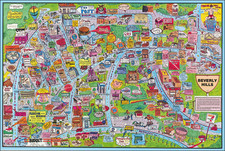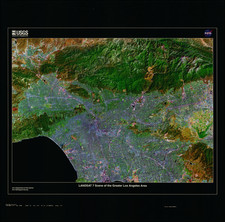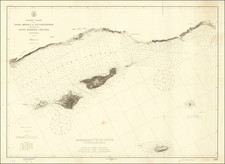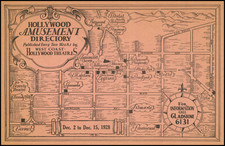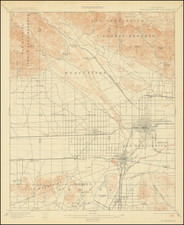Rare broadsheet map of a section of West Hollywood, between Santa Monica Blvd and Willoughby, offering details of lots for sale by Frank H. Ayres.
At the west side is Crescent Avenue (now Fairfax).
The verso includes lot pricing information, financing terms, restrictions and Red Line car information (two redlines, 15 minutes between).
The earliest of Ayres advertisements promoting McNair Place appeared in the Los Angeles Times in July 1919, with the name appearing in his advertisements until 1921, however the text of the advertisement states that all 457 lots had been sold by January 1920.
West Hollywood
The first European settlers reached the area of West Hollywood in the years following the 1770 arrival of the Gaspar de Portola's expeditionary force stopped just south of the Santa Monica Mountains near what would become West Hollywood to draw pitch (brea in Spanish) from tar pits to waterproof their belongings and to say Mass.
By 1780, what became the "Sunset Strip" was the major connecting road for El Pueblo de Los Angeles, and all ranches westward to the Pacific Ocean. This land passed through the hands of various owners during the next one hundred years, and it was called names such as "La Brea" and "Plummer" that are listed in historical records. Most of this area was part of the Rancho La Brea, and eventually it came to be owned by the Henry Hancock family.[11]
During the final decade years of the nineteenth century, the first large land reconstruction of the town of "Sherman" significantly accelerated the development of the region. In what would later become West Hollywood—the town of "Sherman"—was established by Moses Sherman and his partners of the Los Angeles Pacific Railroad, an interurban railroad line which later became part of the Pacific Electric Railway system. Sherman became the location of the railroad's main shops, railroad yards, and "car barns". Many working-class employees of the railroad settled in this town. It was during this time that the city began to earn its reputation as a loosely regulated, liquor-friendly (during Prohibition) place for eccentric people wary of government interference.
In 1925 Sherman adopted "West Hollywood", "...a moniker pioneered earlier in the decade by the West Hollywood Realty Board" as its informal name, though it remained under the governance of Los Angeles County.
For many decades, the area that is now the city of West Hollywood was an unincorporated area in the midst of Los Angeles. Because gambling was illegal in the city of Los Angeles, but still legal in Los Angeles County, the 1920s saw the proliferation of many casinos, night clubs, etc., along Sunset Boulevard (which starts near downtown Los Angeles and runs westward).











![[Southern California Citrus Fair Promotional Broadside] Riverside Exhibit / Removed From Riverside Cal. to Armory Hall, Los Angles, Open Day & Eve'ng from Feb 29 to March 6th 1888](https://storage.googleapis.com/raremaps/img/small/74529.jpg)
